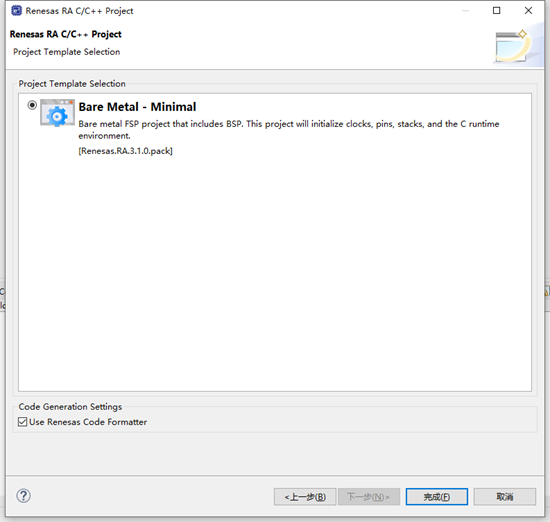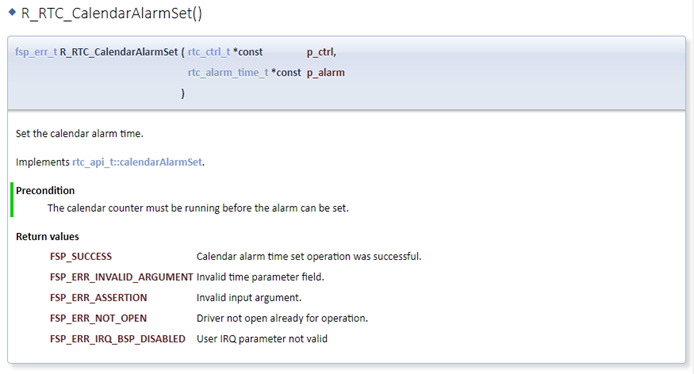

瑞萨e2studio----RTC时钟日历、闹钟、周期性中断
描述

1.概述
本篇文章主要介绍如何使用e2studio对瑞萨进行RTC配置,并且配置RTC时钟日历,产生1s的中断让串口打印实时数据。
RTC时钟模块是一个时间外设,主要用于日期时间的存储和控制,有别于一般MCU中的Timer,RTC时钟有两种计时模式,日期模式和计时模式,RTC常见的操作包括设置时间、设置定时闹铃、配置周期性中断以及启动或停止操作。
2.硬件准备
首先需要准备一个开发板,这里我准备的是芯片型号 R7FA2L1AB2DFL 的开发板。
3.新建工程

4.工程模板

5.保存工程路径

6.芯片配置
本文中使用R7FA2L1AB2DFL来进行演示。

7
7.工程模板选择

8.RTC配置
点击Stacks->New Stack->Driver->Timers -> RTC Driver on r_rtc。

9.RTC属性配置

10.设置E2STUDIO堆栈

11.e2studio的重定向printf设置

C++ 构建->设置->GNU ARM Cross C Linker->Miscellaneous去掉Other linker flags中的 “--specs=rdimon.specs”

12.printf输出重定向到串口
打印最常用的方法是printf,所以要解决的问题是将printf的输出重定向到串口,然后通过串口将数据发送出去。
注意一定要加上头文件#include
#ifdef __GNUC__ //串口重定向
#define PUTCHAR_PROTOTYPE int __io_putchar(int ch)
#else
#define PUTCHAR_PROTOTYPE int fputc(int ch, FILE *f)
#endif
PUTCHAR_PROTOTYPE
{
err = R_SCI_UART_Write(&g_uart0_ctrl, (uint8_t *)&ch, 1);
if(FSP_SUCCESS != err) __BKPT();
while(uart_send_complete_flag == false){}
uart_send_complete_flag = false;
return ch;
}
int _write(int fd,char *pBuffer,int size)
{
for(int i=0;i;i++)>
13.R_RTC_Open()函数原型

故可以用R_RTC_Open()函数进行初始化和开启RTC。
/* Initialize the RTC module*/
err = R_RTC_Open(&g_rtc0_ctrl, &g_rtc0_cfg);
/* Handle any errors. This function should be defined by the user. */
assert(FSP_SUCCESS == err);
14.R_RTC_CalendarTimeSet()函数原型

故可以用R_RTC_CalendarTimeSet()函数进行设置当前日历时间。
/* R_RTC_CalendarTimeSet must be called at least once to start the RTC */
R_RTC_CalendarTimeSet(&g_rtc0_ctrl, &set_time);
15.R_RTC_PeriodicIrqRateSet()函数原型

故可以用R_RTC_PeriodicIrqRateSet()函数进行设置周期中断。
/* Set the periodic interrupt rate to 1 second */
R_RTC_PeriodicIrqRateSet(&g_rtc0_ctrl, RTC_PERIODIC_IRQ_SELECT_1_SECOND);
16.R_RTC_CalendarAlarmSet()函数原型

故可以用R_RTC_CalendarAlarmSet()函数进行设置闹钟。
R_RTC_CalendarAlarmSet(&g_rtc0_ctrl, &set_alarm_time1);
17.R_RTC_CalendarTimeGet()函数原型

故可以用R_RTC_CalendarTimeGet ()函数进行获取RTC计数时间。
R_RTC_CalendarTimeGet(&g_rtc0_ctrl, &get_time);//获取RTC计数时间
18.设定时间
开启RTC之后需要设定当前的时间,可以通过 R_RTC_CalendarTimeSet( &g_rtc0_ctrl , &set_time ) 设定时间,具体时间可以通过set_time进行修改,设置如下所示。
/* rtc_time_t is an alias for the C Standard time.h struct 'tm' */
rtc_time_t set_time =
{
.tm_sec = 0, /* 秒,范围从 0 到 59 */
.tm_min = 30, /* 分,范围从 0 到 59 */
.tm_hour = 12, /* 小时,范围从 0 到 23*/
.tm_mday = 20, /* 一月中的第几天,范围从 1 到 31*/
.tm_mon = 11, /* 月份,范围从 0 到 11*/
.tm_year = 121, /* 自 1900 起的年数,2021为121*/
.tm_wday = 5, /* 一周中的第几天,范围从 0 到 6*/
// .tm_yday=0, /* 一年中的第几天,范围从 0 到 365*/
// .tm_isdst=0; /* 夏令时*/
};
19.设定周期性中断
若要用RTC进行固定延时中断,可以用 R_RTC_PeriodicIrqRateSet ( rtc_ctrl_t *const p_ctrl , rtc_periodic_irq_select_t const rate ) 来进行设置,例如设置1s,设置如下:
R_RTC_PeriodicIrqRateSet( &g_rtc0_ctrl , RTC_PERIODIC_IRQ_SELECT_1_SECOND );
每当周期性中断产生时,可以触发回调函数的事件RTC_EVENT_PERIODIC_IRQ。
20.设定日历闹钟时间
开启RTC之后可以设定需要日历闹钟时间,可以通过 R_RTC_CalendarAlarmSet( &g_rtc0_ctrl , &set_alarm_time )设定闹钟时间,具体时间可以通过 set_alarm_time 进行修改,设置如下所示。
下方例程只设置了 sec_match 为1,故每过一分钟到5s的时候的时候都会触发闹铃,若设置每天响铃一次,则需要将 min_match 和 hour_match 都设置为1。
rtc_alarm_time_t set_alarm_time=
{
.time.tm_sec = 5,
.time.tm_sec = 5, /* 秒,范围从 0 到 59 */
.time.tm_min = 30, /* 分,范围从 0 到 59 */
.time.tm_hour = 12, /* 小时,范围从 0 到 23*/
.time.tm_mday = 20, /* 一月中的第几天,范围从 1 到 31*/
.time.tm_mon = 11, /* 月份,范围从 0 到 11*/
.time.tm_year = 121, /* 自 1900 起的年数,2021为121*/
.time.tm_wday = 5, /* 一周中的第几天,范围从 0 到 6*/
.sec_match = 1,
.min_match = 0,
.hour_match = 0,
.mday_match = 0,
.mon_match = 0,
.year_match = 0,
.dayofweek_match = 0,
};
21.演示效果
设置每过1s打印一次当前时间,设置过1分钟,在5秒时候闹铃。


22.完整代码
#include "hal_data.h" #include FSP_CPP_HEADER void R_BSP_WarmStart(bsp_warm_start_event_t event); FSP_CPP_FOOTER fsp_err_t err = FSP_SUCCESS; volatile bool uart_send_complete_flag = false; void user_uart_callback (uart_callback_args_t * p_args) { if(p_args->event == UART_EVENT_TX_COMPLETE) { uart_send_complete_flag = true; } } #ifdef __GNUC__ //串口重定向 #define PUTCHAR_PROTOTYPE int __io_putchar(int ch) #else #define PUTCHAR_PROTOTYPE int fputc(int ch, FILE *f) #endif PUTCHAR_PROTOTYPE { err = R_SCI_UART_Write(&g_uart0_ctrl, (uint8_t *)&ch, 1); if(FSP_SUCCESS != err) __BKPT(); while(uart_send_complete_flag == false){} uart_send_complete_flag = false; return ch; } int _write(int fd,char *pBuffer,int size) { for(int i=0;ievent == RTC_EVENT_PERIODIC_IRQ) rtc_flag=1; else if(p_args->event == RTC_EVENT_ALARM_IRQ) rtc_alarm_flag=1; } /*******************************************************************************************************************//** * main() is generated by the RA Configuration editor and is used to generate threads if an RTOS is used. This function * is called by main() when no RTOS is used. **********************************************************************************************************************/ void hal_entry(void) { /* TODO: add your own code here */ err = R_SCI_UART_Open(&g_uart0_ctrl, &g_uart0_cfg); assert(FSP_SUCCESS == err); /* Initialize the RTC module*/ err = R_RTC_Open(&g_rtc0_ctrl, &g_rtc0_cfg); /* Handle any errors. This function should be defined by the user. */ assert(FSP_SUCCESS == err); /* R_RTC_CalendarTimeSet must be called at least once to start the RTC */ R_RTC_CalendarTimeSet(&g_rtc0_ctrl, &set_time); /* Set the periodic interrupt rate to 1 second */ R_RTC_PeriodicIrqRateSet(&g_rtc0_ctrl, RTC_PERIODIC_IRQ_SELECT_1_SECOND); R_RTC_CalendarAlarmSet(&g_rtc0_ctrl, &set_alarm_time); uint8_t rtc_second= 0; //秒 uint8_t rtc_minute =0; //分 uint8_t rtc_hour =0; //时 uint8_t rtc_day =0; //日 uint8_t rtc_month =0; //月 uint16_t rtc_year =0; //年 uint8_t rtc_week =0; //周 rtc_time_t get_time; while(1) { if(rtc_flag) { R_RTC_CalendarTimeGet(&g_rtc0_ctrl, &get_time);//获取RTC计数时间 rtc_flag=0; rtc_second=get_time.tm_sec;//秒 rtc_minute=get_time.tm_min;//分 rtc_hour=get_time.tm_hour;//时 rtc_day=get_time.tm_mday;//日 rtc_month=get_time.tm_mon;//月 rtc_year=get_time.tm_year; //年 rtc_week=get_time.tm_wday;//周 printf(" %d y %d m %d d %d h %d m %d s %d w\n",rtc_year+1900,rtc_month,rtc_day,rtc_hour,rtc_minute,rtc_second,rtc_week); } if(rtc_alarm_flag) { rtc_alarm_flag=0; printf("/************************Alarm Clock********************************/\n"); } } #if BSP_TZ_SECURE_BUILD /* Enter non-secure code */ R_BSP_NonSecureEnter(); #endif };i++)>原创:By RA_Billy Xiao
原文标题:瑞萨e2studio----RTC时钟日历&闹钟&周期性中断
文章出处:【微信公众号:RA生态工作室】欢迎添加关注!文章转载请注明出处。
-
【瑞萨RA2L1入门学习】03. RTC 时钟日历&闹钟&周期性中断2025-03-07 989
-
电子时钟制作(瑞萨RA)(6)----配置RTC时钟及显示时间2023-12-01 1842
-
基于STM32CubeMX的实时时钟(RTC)配置2023-03-21 5224
-
STM32CubeMX-实时时钟(RTC)2023-01-14 3243
-
如何从RTC产生周期性闹钟中断?2023-01-12 545
-
瑞萨e2studio----看门狗WDT2021-12-02 2836
-
瑞萨e2studio----独立看门狗IWDT2021-11-26 2372
-
STM32CubeMX | 40 - 实时时钟RTC的使用(日历和闹钟)2021-11-23 1008
-
如何利用STM32的RTC实时时钟去提供时钟日历呢2021-11-22 2088
-
瑞萨e2studio----PWM2021-11-02 2013
-
RTC时钟详细步骤2021-08-18 1319
-
Firefly关于-RTC 使用简介2019-11-20 3039
全部0条评论

快来发表一下你的评论吧 !

